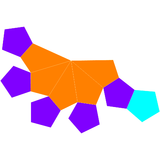Gyroelongated_pentagonal_pyramid
Gyroelongated pentagonal pyramid
11th Johnson solid (16 faces)
In geometry, the gyroelongated pentagonal pyramid is one of the Johnson solids (J11). As its name suggests, it is formed by taking a pentagonal pyramid and "gyroelongating" it, which in this case involves joining a pentagonal antiprism to its base.
A Johnson solid is one of 92 strictly convex polyhedra that is composed of regular polygon faces but are not uniform polyhedra (that is, they are not Platonic solids, Archimedean solids, prisms, or antiprisms). They were named by Norman Johnson, who first listed these polyhedra in 1966.[1]
It can also be seen as a diminished icosahedron, an icosahedron with the top (a pentagonal pyramid, J2) chopped off by a plane. Other Johnson solids can be formed by cutting off multiple pentagonal pyramids from an icosahedron: the pentagonal antiprism and metabidiminished icosahedron (two pyramids removed), and the tridiminished icosahedron (three pyramids removed).

